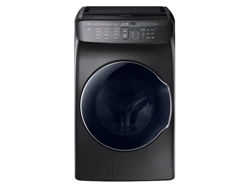Documents: Go to download!
- Owner's manual - (English, French, Spanish)
- Installation
- Operations
- Maintenance
- Troubleshooting
- Specifications
Table of contents
User manual Washer
Installation
Follow these instructions carefully to ensure proper installation of the washer and to prevent accidents when doing laundry
Unpacking your washer
Unpack your washer and inspect it for shipping damage. Make sure you have received all the items shown below. If your washer was damaged during shipping, or you do not have all of the items, contact 1-800-SAMSUNG (1-800-726-7864). To prevent personal injury or strain, wear protective gloves whenever lifting or carrying the unit.
WARNING Packing materials can be dangerous to children; Keep all packing material (plastic bags, polystyrene, etc.) well out of children’s reach.
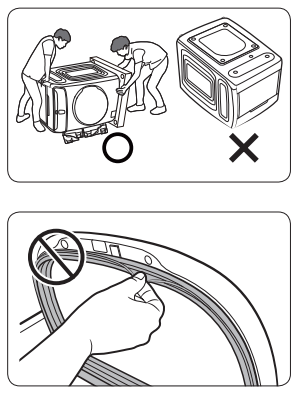
CAUTION When unpacking the washer, a 2 person collaboration is needed. To remove the cushion bottom of the packing materials, do not tip the washer over on its front. When you lay the washer down to remove the carton base, protect the sides of the washer and lay it down carefully. Never lay your washer on its back or front.
What’s included
Make sure all the parts are included in the product package. If you have a question about the washer or the parts, contact a local Samsung customer center or your retailer.
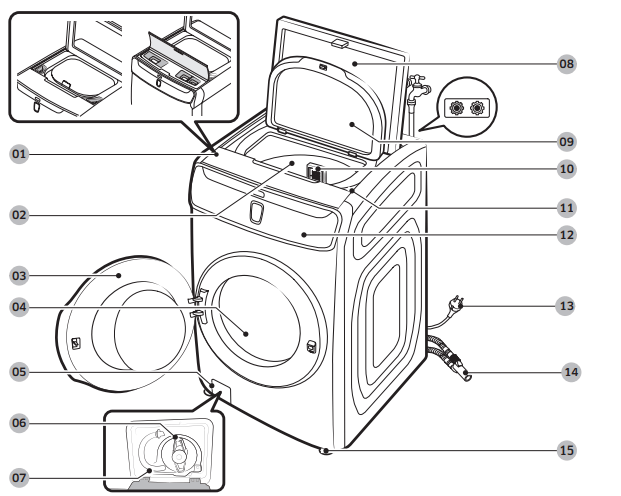
01 Lower detergent compartment
02 Tub
03 Front door
04 Drum
05 Filter cover
06 Pump filter
07 Emergency drain tube
08 Top door 09 Protective cover (inner)
10 Lint filter
11 Upper detergent compartment
12 Main panel
13 Power plug
14 Pipe connector (Upper drain hose & lower drain hose)
15 Levelling legs
Accessories (supplied)
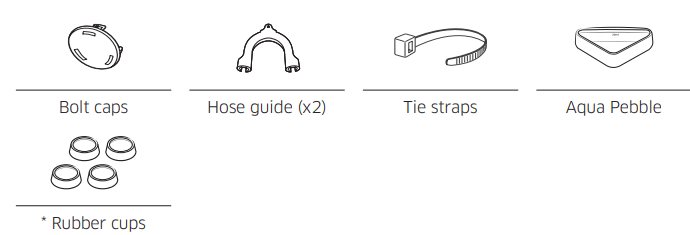
* When not using the pedestal, use the rubber cups for soft floors or surfaces.
Accessories (not supplied)
You must purchase these items at a local service center.

Tools required for installation (not supplied)

Installation requirements
Electrical supply and grounding
- AC 120 V / 60 Hz fuse or circuit breaker is required.
- Use an individual branch circuit. Connect only the washer to the circuit.
WARNING
- Do NOT use an extension cord.
- Use only the power cord that comes with the washer.
- Do NOT connect the ground wire to plastic plumbing, gas lines, or hot water pipes.
- Improperly connected grounding conductors may cause electric shock.
- To ensure proper grounding, the washer comes with a power cord featuring a three-prong grounding plug for use in a properly installed and grounded outlet. Check with a qualified electrician or service person if you are not sure about the grounding.
- Do not modify the provided plug. If it does not fit the outlet, call a qualified electrician to install a proper outlet.
- To prevent unnecessary risk of fire, electrical shock, or personal injury, all wiring and grounding must be done in accordance with local codes, or in the absence of local codes, in accordance with the National Electrical Code, ANSI/ NFPA No. 70-Latest Revision (for the U.S.) or the Canadian Electrical Code CSA C22.1 – Latest Revisions and local codes and ordinances. It is your responsibility to provide adequate electrical service for your washer
Water supply
Water pressure less than 20 psi (137 kPa) may cause the water valve not to close completely. Or, it may take longer to fill the drum, causing the washer to turn off. Taps must be within 4 feet (122 cm) from the rear of the washer so that the provided inlet hoses reach the washer. To reduce the risk of leaks:
- Make sure taps are easily accessible.
- Turn off the taps when the washer is not in use.
- Check for any leaks at the water inlet hose fittings on a regular basis.
Drain
Samsung recommends a standpipe 18 in (46 cm) high. The drain hose must be connected through the hose clip to the standpipe, and the standpipe must fully cover the drain hose
Flooring
For best performance, the washer must be installed on a solid floor. Wood floors may need to be reinforced to minimize vibration and/or unbalanced loads. Carpeting and soft tile surfaces do not provide good resistance to vibrations and may cause the washer to move slightly during the spin cycle.
CAUTION Do NOT install the washer on a platform or a poorly supported structure.
Water temperature
Do not install the washer in areas where water may freeze as the washer always retains some water in its water valves, pumps, and/or hoses. Frozen water left in the connection parts may cause damage to belts, the pump, and other components of the washer
Alcove or closet installation
Minimum clearance for stable operation:

If both the washer and a dryer are installed in the same location, the front of the alcove or closet must have two unobstructed air openings for a combined minimum total area of 72 in² (465 cm²). Your washer alone does not require a specific air opening.
Installation on a pedestal
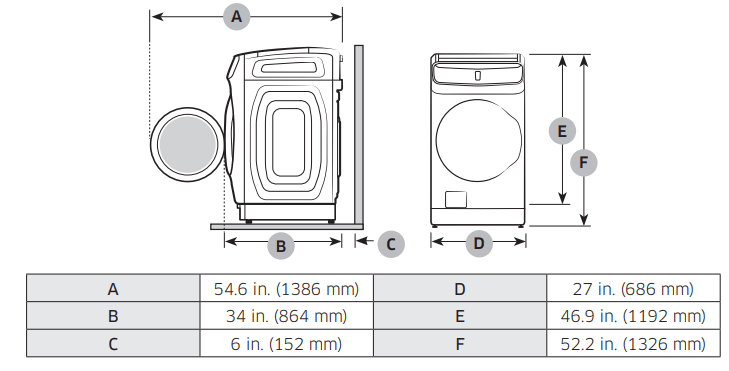
Side by side installation

*This clearance is not applicable to standalone washers.
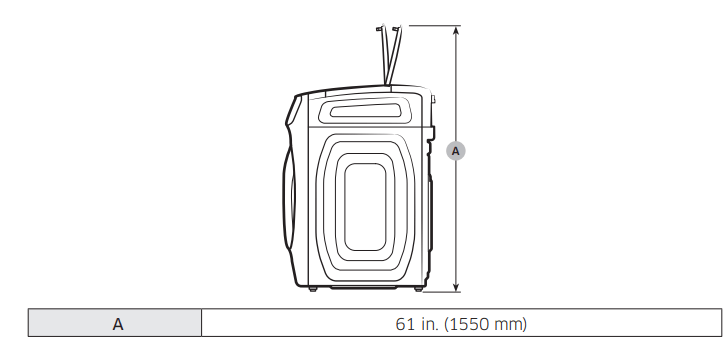
Step-by-step installation
STEP 1 Select a location
Location requirements:
- A solid, level surface without carpeting or flooring that may obstruct ventilation
- No direct sunlight
- Adequate room for ventilation and wiring
- Ambient temperature always higher than the freezing point (32 °F / 0 °C)
- Away from heat sources
STEP 2 Remove the shipping bolts
Unpack the product package and remove all shipping bolts (x7).
1. Loosen all shipping bolts on the rear of the machine using the wrench.
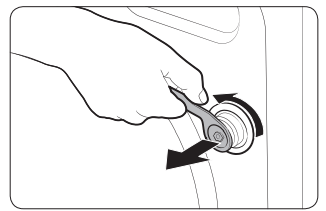
NOTE An adjustable wrench or 10 mm openend wrench is required for removing the shipping bolts.
2. Fill the holes with the supplied plastic bolt caps. Keep the shipping bolts for future use.
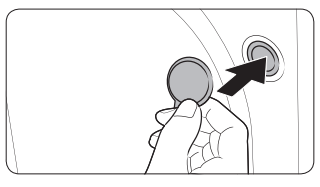
STEP 3 Adjust the levelling legs

1. Gently slide the washer into position. Excessive force may damage the levelling legs.
2. Level the washer by manually adjusting the levelling legs.
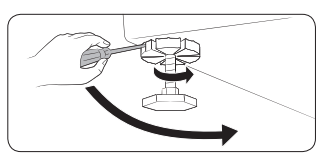
3. When levelling is complete, tighten the nuts using the wrench.
NOTE An adjustable wrench or 17 mm openend wrench is required to loosen or tighten the leveling legs
STEP 4 Put the rubber cups on the legs (Only for soft floor or surface)
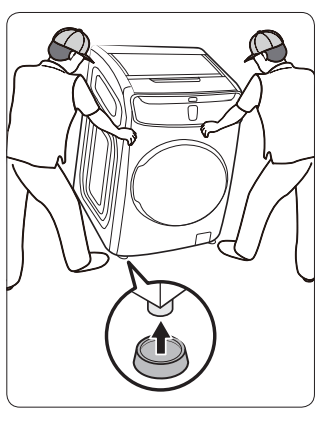
To protect a soft floor or surface, use the provided rubber cups. You don’t need to use the rubber cups on a hard floor or on a pedestal.
1. Let two or more persons hold both sides of the washer.
2. While slanting the washer to one side, put the rubber cups under each leg of the washer one by one.
STEP 5 Connect the water hoses
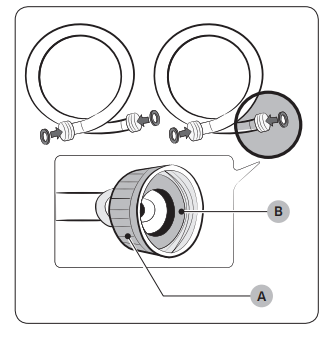
CAUTION
- Make sure you use a new water hose and that there are rubber gaskets (B) inside the couplings (A) at either end of each water hose. A water hose without the gasket may leak.
- If there is a water leak, stop using the washer and contact a local Samsung service center. A water leak may cause electric shock
- Do not stretch the water hose by force. If the hose is too short, replace the hose with a longer, high-pressure hose.
- To prevent leaks, make sure both water hoses are not bent or kinked. A water leak may cause electric shock.
To connect the water hoses to the taps:
1. Connect one end of each water hose to the Hot or Cold tap.
2. Turn the fittings by hand until they are tight, and then tighten them an additional two-thirds of a turn with a pliers. To prevent damage, do not overtighten the fittings.
3. When done, pull the water hoses up and down to check if they are properly connected.
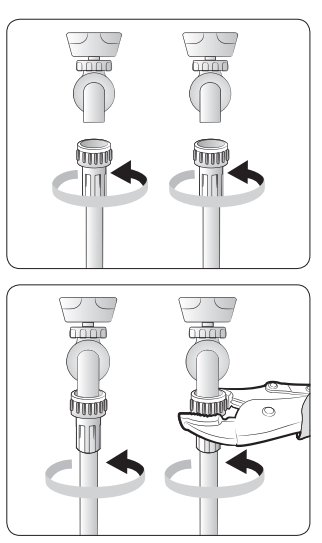
4. Put the other ends of the hoses into a bucket and open the taps for 10-15 seconds to remove impurities. When done, close the taps.
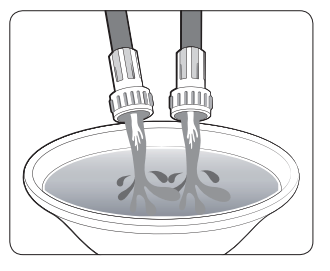
5. Connect the other ends of the water hoses to the corresponding inlets on the rear of the machine as specified. Make sure the hot water hose is connected to the hot inlet, and the cold water hose to the cold inlet.
6. Repeat step 2 above on the other fittings. Make sure both water hoses are connected properly. See the ‘4C’ information code for troubleshooting.
7. Open both taps, and then check if there is a leak.
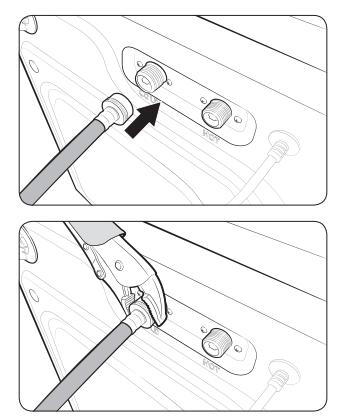
CAUTION To prevent water hoses from being bent or kinked, make sure there is at least a 6-inch (150 mm) space between the washer and the rear wall.
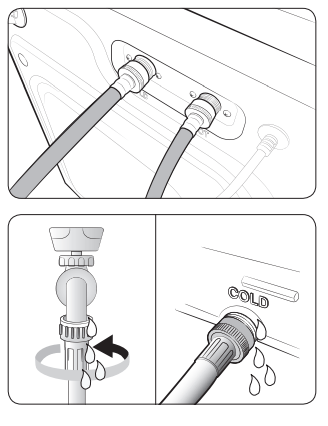
NOTE If you do not want to use hot water, insert the inlet cap into the hot water inlet. You must purchase the inlet cap. If the hot water inlet is closed with the inlet cap, you must select Cold for the water temperature. All other water indicators turn off.
STEP 6 Position the drain system
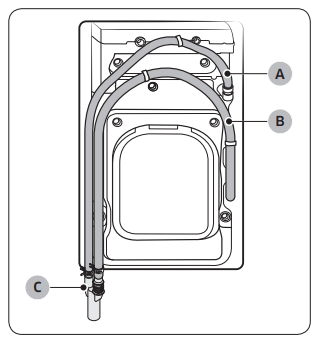
The pipe connector is attached on the product.
NOTE
A : Upper drain hose
B : Lower drain hose
C : Pipe connector
In a wall standpipe drain system
The drain hose must be placed into a wall standpipe drain system.
After inserting 2 drain hoses into the pipe connector, use tie straps to bind the drain hoses, and then insert the pipe connector into the wall standpipe.
When complete, use the tie straps to bind the drain hose to the water hose.
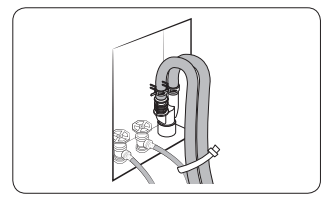
WARNING Make sure to use the pipe connector before inserting the drain hoses. Without the pipe connector, the drain hose will not be positioned securely inside the wall standpipe, causing a water leak.
The pipe connector can be positioned in the following ways:

Over the edge of a wash basin
The pipe connector (B) must be placed at a height of between 24 in. (60 cm) and 35 in. (90 cm) from the floor. To keep the spout of the drain hose bent, use the supplied plastic hose guide (A). Secure the guide to the wall using a hook to ensure stable drainage
NOTE B : Pipe Connector
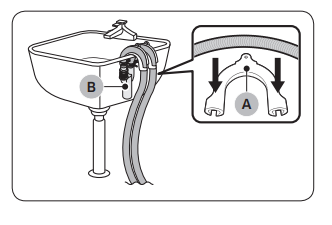
ln a standpipe or laundry tub
The laundry tub (B) or standpipe (C) must be no shorter than 18 in. (46 cm) and no higher or longer than 96 inches (245 cm). Make sure the pipe connector and the standpipe are not airtight. The height of the standpipe (E) must be 43 in. (1100 mm) or higher from the floor.
NOTE A: Hose guide / D: Tie straps / F : Pipe Connector / G: 85 mm
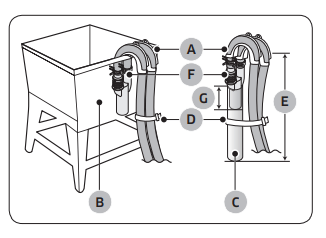
CAUTION
- Do not extend the (Y-shaped) pipe connector using an extension hose.
- Make sure you face the tip of the pipe connector downwards to the drain hole. Positioning the connector tip elsewhere can cause the drained water to flow backward.

Dimensions of the pipe connector

To position without the pipe connector
If you do not use the pipe connector, each drain hose can be positioned in the following ways:
Over the edge of a wash basin
The drain hose must be placed at a height of between 24 in. (60 cm) and 35 in. (90 cm) from the floor. To keep the spout of the drain hose bent, use the supplied plastic hose guide (A). Secure the guide to the wall using a hook to ensure stable drainage
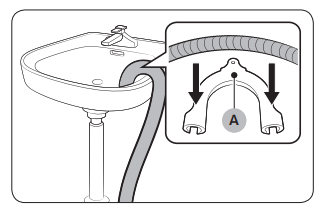
ln a standpipe or laundry tub
The laundry tub (B) or standpipe (C) must be no shorter than 18 in. (46 cm) and no higher or longer than 96 inches (245 cm). Make sure the drain hose and the standpipe are not airtight. The height of the standpipe (E) must be 43 in. (1100 mm) or higher from the floor.
NOTE A: Hose guide / D: Tie straps

CAUTION
- Connect the hose guide (A) within 3–5 in. (7.6–12.7 cm)* from the end of the drain hose. If the drain hose is extended beyond the end of the hose guide, mold or microorganisms could spread inside the washer.
- The drain hose can be installed up to 96 in. (245 cm) high, but the draining capability can be reduced at the maximum height. Water remaining in the drain system may cause an odor.
- If the drain hose is installed less than 18 in. (46 cm) high, water can be drained during the process due to a siphon phenomenon. If this happens, a ‘4C’ information code appears on the display.
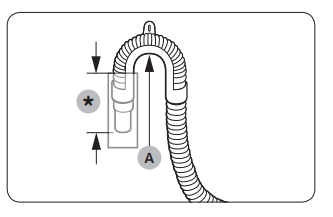
To position using the pipe connector
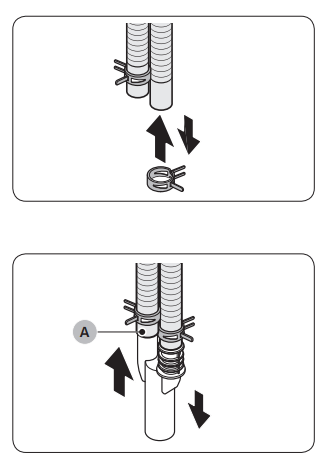
You washer comes with a pipe connector that is designed to join the upper drain hose and the lower drain hose. You can choose to use the connector to combine two drain hoses into a single outlet.
1. Insert the clamp ring on the end of the drain hose, one for each drain hose. A
2. Insert the pipe connector into the drain hoses. Make sure the longer side (A) fits into the drain hose running from the lower washer.
3. Fix the position of the clamp rings near the end of each hose.
- To remove the pipe connector, follow these steps above in the reverse order
- Before using your washer, make sure to remove the dehumidifying agent (silica gel) from inside the upper washer.
- Do not eat or swallow the dehumidifying agent (silica gel).
- The protective cover may form moisture on its surface after the washer has checked for a leak to ensure normal operation. This is normal, and does not indicate a defective part. Open the cover for a moment to remove the moisture.
- Plug the power cord into an AC 120 V / 60 Hz / 15 AMP approved electrical outlet protected by a fuse or circuit breaker. Then, press POWER to turn on the washer.
Operations
Your dual loading washer features the upper and the lower washers for your convenience. The upper washer is an automatic tub loader that is designed to wash relatively small loads while the lower washer is a drum loader that takes care of normal or relatively heavy loads. The main panel is divided into 2 independent control panels.
Upper washer
Control panel

| Cycle | Description |
| NORMAL |
|
| DELICATES |
|
| ACTIVE WEAR |
|
| RINSE+SPIN |
|
Lower washer
Control panel

| 01 Cycle buttons |
Press the button repeatedly to select a desired cycle listed above each button. For more information, see the Cycle overview section on page 48.
|
| 02 POWER | Press to turn the lower washer on or off. |
| 03 START/PAUSE | Press to start operation or press to stop operation temporarily |
| 04 Status bar | The status bar shows current cycle information and estimated time remaining or an information code if the lower washer needs to be checked. |
| 05 Temp. |
Extra Hot: Heavily soiled, colorfast items. Only available with NORMAL, HEAVY DUTY, SANITIZE and Self Clean+.
|
| 06 Spin |
|
| 07 Soil |
Press the button to select the soil level/washing time.
|
| 08 Pre Soak | This adds 30 minutes of soaking time at the start of the wash cycle for better stain removal. |
| 09 Steam |
With the Steam option selected, the washer senses the weight of the load and controls the steam effect according to the load size. This improves washing performance. Cycles available with the Steam option are: NORMAL, HEAVY DUTY, BEDDING, WHITES, and SANITIZE. 1. Select a cycle. For applicable cycles, see above. 2. Press Steam. 3. Add detergent and fabric softener as instructed. 4. Press START/PAUSE to start the cycle. |
| 10 Extra Rinse | Adds an additional rinse at the end of the cycle to remove laundry additives more thoroughly. |
| 11 Delay End |
You can set the washer to finish your wash automatically at a later time by choosing a delay of between 1 to 24 hours (in 1 hour increments). The hour displayed indicates the time the wash will finish. 1. Select a cycle. Then, change the cycle settings if necessary. 2. Press Delay End repeatedly until a desired end time is set. 3. Press START/PAUSE. The lamp indicator next to the Delay End button turns on with the clock running. 4. To cancel Delay End, restart the washer by pressing POWER. Real-life case You want to finish a two-hour cycle 3 hours from now. To do this, you add the Delay End option to the current cycle with a 3-hour setting, and then press START/PAUSE at 2:00 p.m. The washer starts operating at 3:00 p.m. and ends at 5:00 p.m. Provided below is the time line for this example.
|
| 12 Self Clean+ |
Cleans the drum by removing dirt and mold from the drum.
|
| 13 Smart Control | After connecting the lower washer to your home network using the SmartThings app, you can control the washer remotely. When started, the Smart Control indicator blinks and the front door locks. The washer enters waiting mode and waits for remote commands. For more information, visit the SmartThings app page. |
Cycle overview
Standard cycles
| Button | Cycle | Description |
| CYCLE 2 | DELICATES |
|
| CYCLE 3 | QUICK WASH |
|
| CYCLE 3 | PERM PRESS |
|
| CYCLE 3 | RINSE+SPIN |
|
Steam cycles
| Button | Cycle | Description |
| CYCLE 1 | NORMAL |
|
| CYCLE 1 | HEAVY DUTY |
|
| CYCLE 1 | SANITIZE |
|
| CYCLE 2 | WHITES |
|
| CYCLE 2 | BEDDING |
|
Simple steps to start
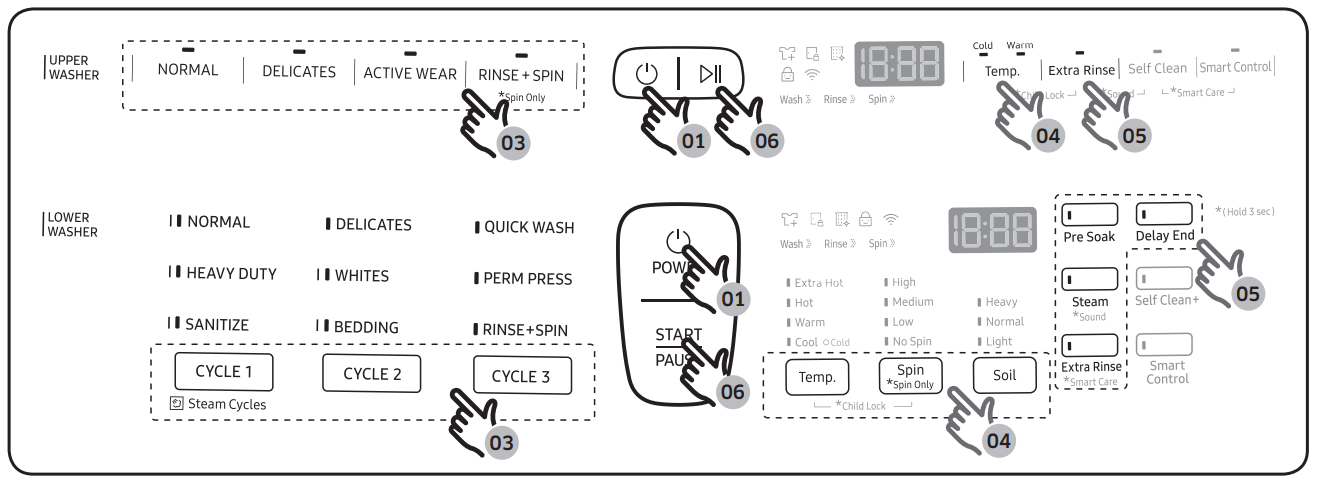
1. Press POWER on the control panel of a desired washer (upper/lower) to turn the washer on.
2. Put laundry into the washer.
3. Select a cycle.
4. Change the cycle settings (temperature and/or soil level) as appropriate to the laundry.
5. Select cycle options as needed.
6. Press START/PAUSE.
To change the cycle during operation
1. Press START/PAUSE to stop operations temporarily.
2. Select a different cycle.
3. Press START/PAUSE again to start the new cycle
WARNING
- Do not put anything on top of your washer while it is running.
- While the lower washer is operating, the protective cover may have wet steam due to the temperature difference between the upper and lower parts of the washer. CAUTION
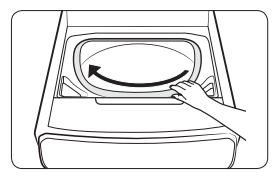
SmartThings
Wi-Fi connection
On your smartphone, go to Settings and turn on the wireless connection and select an AP (Access Point).
This appliance supports the Wi-Fi 2.4 GHz protocols.
Download
On an app market (Google Play Store, Apple App Store, Samsung Galaxy Apps), find the SmartThings app with a search term of “SmartThings”. Download and install the app on your device.
Log in
You must first log into SmartThings with your Samsung account. To create a new Samsung account, follow the instructions on the app. You don’t need a separate app to create your account.
To register your appliance to SmartThings
1. Make sure your smartphone is connected to a wireless network. If not, go to Settings and turn on the wireless connection and select an AP (Access Point).
2. Open SmartThings on your smartphone.
3. If a message of “A new device is found.”, select Add.
4. If no message appears, select + and select your appliance in a list of devices available. If your appliance is not listed, select Device Type > Specific Device Model, and then add your appliance manually.
5. Register your appliance to the SmartThings app as follows.
a. Add your appliance to SmartThings. Make sure your appliance is connected to SmartThings.
b. When registration is complete, your appliance appears on your smartphone.
Special features
Child Lock
To prevent children or infants from accidently starting or setting the washer, Child Lock locks all buttons except for the POWER button. Note that each washer operates independently and has its own Child Lock function. If you want to activate Child Lock for the upper or lower washer, you must press the appropriate buttons on the upper or lower washer's control panel.
To activate Child Lock
- Press and hold Temp. and Spin (or Temp. and Extra Rinse for the upper washer) simultaneously for 3 seconds. The door locks and the Child Lock indicator turns on. Then, press START/PAUSE to activate.
To deactivate Child Lock temporarily
- You can deactivate Child Lock temporarily for 1 minute. To do this, press and hold Temp. and Spin (or Temp. and Extra Rinse for the upper washer) simultaneously for 3 seconds. The door is unlocked for 1 minute and the Child Lock indicator blinks.
To cancel Child Lock
- Press and hold Temp. and Spin (or Temp. and Extra Rinse for the upper washer) for 3 seconds to deactivate, and then press and hold the buttons again for 3 seconds to release Child Lock. The door unlocks and the Child Lock indicator turns off
Smart Care
The Smart Care function helps you diagnose and troubleshoot your washer if it has an issue. To enable this function, you must first download the Samsung Smart Washer app from the Play Store or the Apple Store, and install it on a mobile device that has a builtin camera. The Smart Care function has been optimized for: Galaxy and iPhone series devices. (It is not supported by some models.) As the washer operates, it runs self-diagnosis in the background. If it senses an issue to check, it displays an information code on the display which you can scan using the app’s Smart Care function, which then displays detailed information about the code for your reference.
1. Press and hold Extra Rinse (or Self Clean and Smart Control for the upper washer) on the washer for 3 seconds to enter the Smart Care mode.
2. Run the Samsung Smart Washer app on your mobile device, and then tap Smart Care.
3. Hold the mobile device so that the mobile device and the washer’s status bar face each other. The app will recognize the information code automatically.
4. When the information code is recognized correctly, the app provides detailed information about the symptom and recommends further action.
Sound
Mute or unmute the sound (button beeps, indicator beeps and chimes, etc.)
Upper washer
- To mute the alarm sound or beep on the upper washer, press and hold Extra Rinse and Self Clean for 3 seconds. To unmute, press and hold the buttons for 3 seconds again.
Lower washer
- To mute the alarm sound or beep on the lower washer, press and hold Steam for 3 seconds. To unmute, press and hold the button for 3 seconds again.
ATC (Auto Temperature Control)
ATC enables the washer to control water temperatures in each washing cycle using the washer’s internal thermistor. It is designed to maintain certain washing temperatures for best results.
- If you select NORMAL or HEAVY DUTY, you may notice the washer supplying cold water. This is normal because the washer is designed to reduce power consumption.
- In these cycles, the Hot temperature is similar to bath-water temperatures and the Warm temperature to comfortable swimming pool temperatures.
- To wash laundry at a specific temperature, you must choose a different cycle first.
Maintenance
Keep the washer clean to prevent its performance from deteriorating and to preserve its life cycle.
General considerations
Cleaning Surface of the washer
Use a soft cloth with a nonabrasive household detergent. Do not spray water onto the washer.
Exterior
1. Turn off the water taps after finishing the day’s washing. This will shut off the water supply to your washer and prevent the unlikely possibility of damage from escaping water. Leave the door open to allow the inside of your washer to dry out.
2. Use a soft cloth to wipe up all detergent, bleach, or other spills as they occur. Clean the following as recommended below:
- Control panels – Clean with a soft, damp cloth. Do not use abrasive powders or cleaning pads. Do not spray cleaners directly on the panels.
- Cabinet – Clean with soap and water.
Interior Clean the interior of your washer periodically to remove any dirt, soil, odor, mold, mildew, or bacterial residue that may remain in your washer as a result of washing clothes.
Mesh filter
Clean the mesh filter of the water hose once or twice a year.
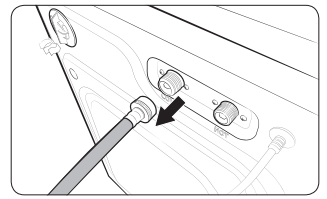
1. Turn off the washer, and then unplug the power cord.
2. Close the taps.
3. Loosen and disconnect the water hose from the back of the washer. Cover the hose with a cloth to prevent water from gushing out.
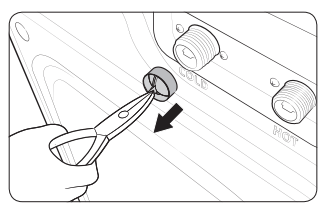
4. Use pliers to pull out the mesh filter from the inlet valve.
5. Submerge the mesh filter deeply in water so that the threaded connector is also submerged.
6. Dry the mesh filter completely in a shaded area.
7. Reinsert the mesh filter into the inlet valve, and reconnect the water hose to the inlet valve.
8. Open the tap.
Recovery from freezing
The washer may freeze when the temperature in its location drops below 32 °F (0 °C).
1. Turn off the washer, and then unplug the power cord.
2. Pour warm water over the tap to loosen the water hose.
3. Disconnect the water hose, and soak it in warm water.
4. Pour warm water into the drum (tub) and leave it for about 10 minutes.
5. Reconnect the water hose to the tap.
If the washer will not be used for an extended period of time
Avoid leaving the washer unused for an extended time. If you intend to leave the washer unused for a long period of time, follow the directions below:
1. Press POWER, and then select RINSE+SPIN.
2. Empty both the drum and the tub, close the door, and then press START/PAUSE.
3. When the cycle is complete, close the tap and disconnect the water hoses.
4. Turn off the washer, and then unplug the power cord.
5. Open the doors to let air circulate through the drum and the tub.
Upper washer
Self Clean
Certain usage and environmental conditions may result in some residue build-up or odor in the washer tub. To prevent this build-up of residue or odor causing bacteria and keep your washer tub fresh and clean, perform the Self Clean cycle at least once a month or every 20 cycles. Perform the recommended procedure below when using the Self Clean cycle.
1. Remove all items from the washer tub and ensure the tub is empty. Laundry left in the tub during the Self Clean cycle may be damaged.
2. Press POWER.
3. Press Self Clean.
4. Press and hold START/PAUSE
CAUTION
- Check the washer tub before using the Self Clean cycle. Remove any remaining water in the tub by running a Spin Only cycle prior to starting the Self Clean cycle
- If there is chlorine bleach left in the washer tub for an extended period of time, rust can occur.
Self Clean reminder 
- After 20 washing cycles, the Self Clean LED reminder icon and the Self Clean cycle LED will blink on the control panel for an hour and then turn off automatically.
- The reminder will appear on the control panel for 5 additional consecutive cycles before turning off. The next reminder will not appear until another 20 cycles have been completed.
Fabric softener/bleach compartment
Both the fabric softener compartment and the bleach compartment on the upper washer are not removable by design to facilitate visual feedback to users. To clean the softener compartment, follow these instructions. Cleaning the bleach compartment is basically the same.
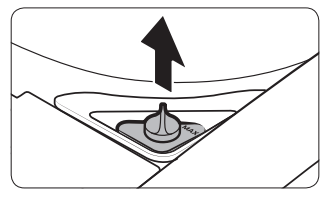
1. Open the top door, and then remove the softener cap.

2. Use a soft brush (for example, a toothbrush) to clean inside the compartment and remove impurities.
3. Run the RINSE+SPIN cycle to rinse the compartment. After supplying water and draining 5 times, the 18-minute cycle completes with the final spin process.
Lint filter
We recommend cleaning the lint filter every 10 washes
1. Remove the lint filter from the filter case on the tub of the upper washer
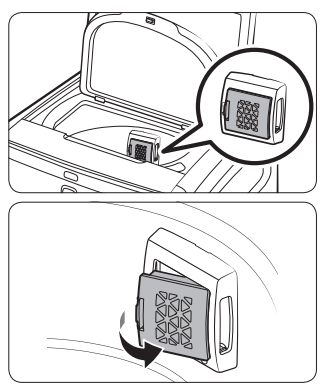
2. Open the filter, and clean it with running water and a brush.
3. When cleaning is complete, close the filter and reinsert it in its original position. You will hear a clicking sound when the filter is inserted correctly.
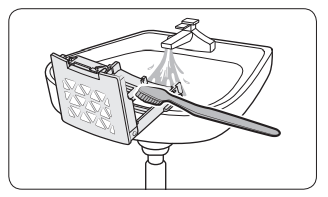
Lower washer
Self Clean+
Certain usage and environmental conditions may result in some residue build-up or odor in the washer drum. To prevent this build-up of residue or odor causing bacteria and keep your washer drum fresh and clean, perform the Self Clean+ cycle at least once a month or every 40 cycles. Perform the recommended procedure below when using the Self Clean+ cycle
1. Remove all items from the washer drum and ensure the drum is empty. Laundry left in the drum during the Self Clean+ cycle may be damaged.
2. Press POWER to turn on the washer.
3. Press Self Clean+.
4. Press and hold START/PAUSE.
NOTE
- The water temperature for Self Clean+ is defaulted to Hot. This temperature cannot be changed.
- In the case where residue is present in the washer drum, add liquid chlorine bleach to the MAX level line in the main-wash compartment before starting the Self Clean+ cycle. Do not add the liquid chlorine bleach to the bleach compartment (This is only the case for Self Clean+ cycle). Do not exceed the max line. Do not use or mix any other detergent or chemicals during the Self Clean+ cycle. If necessary, run a RINSE+SPIN Cycle after the Self Clean+ cycle has completed to help remove any remaining residue.
Self Clean+ reminder 
- After 40 washing cycles, the Self Clean+ LED reminder icon and the Self Clean+ cycle LED will blink on the control panel for an hour and then turn off automatically.
- The reminder will appear on the control panel for 5 additional consecutive cycles before turning off. The next reminder will not appear until another 40 cycles have been completed.
Main wash compartment
The main wash compartment needs to be cleaned periodically to remove buildup of laundry additives.
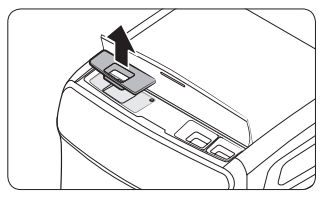
1. Open the top-front cover. Grasp the main wash compartment, and then pull up to remove.
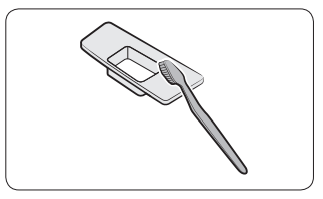
2. Remove all residue and traces of accumulated laundry agents from the compartment. Rinse it with warm water
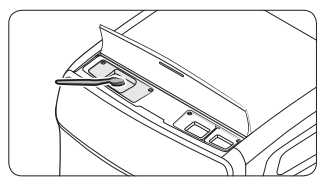
3. To clean the recess of the compartment, use a small, non-metal brush. Remove all residue from all sides of the recess.
4. Reinsert the compartment into place.
Fabric softener/bleach compartment
Both the fabric softener compartment and the bleach compartment on the lower washer are not removable by design to facilitate visual feedback to users. To clean the softener compartment, follow these instructions. Cleaning the bleach compartment is basically the same
1. Open the top-front cover, and then remove the softener cap

2. Use a soft brush (for example, a toothbrush) to clean inside the compartment and remove impurities.
3. Run the RINSE+SPIN cycle to rinse the compartment. After supplying water and draining 5 times, the 19-minute cycle completes with the final spin process.
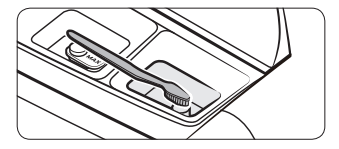
Door diaphragm

1. Open the door and empty the drum.
2. Turn out the diaphragm (sealing or gasket of the drum (A)), and check if it is stained. If so, follow the steps below.
3. Combine 3/4 cups of liquid chlorine bleach and 1 gallon of warm tap water.
4. Wearing rubber gloves, use a soft, clean cloth dipped in the water and chlorine solution to clean the diaphragm.
5. Let stand for 5 minutes, and then wipe up and dry well.
Emergency drain
In case of a power failure, drain the water inside the drum before taking out the laundry.
1. Power off the washer, and then unplug it from the electrical outlet.
2. Gently press the top area of the filter cover to open.
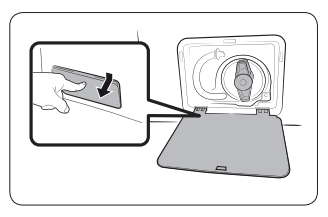
3. Put an empty, spacious container in front of the cover, and stretch the emergency drain tube to the container while holding the tube cap (A).
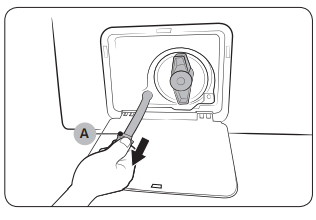
4. Open the tube cap and let water in the Emergency drain tube (B) flow into the container.
5. When done, close the tube cap, and reinsert the tube. Then, close the filter cover.

Pump filter
It is advisable to clean the pump filter 5 or 6 times a year to prevent it from clogging. A clogged pump filter may reduce the bubble effect
1. Turn off the washer, and then unplug the power cord.
2. Drain the remaining water inside the drum. See the Emergency drain section on page 62.
3. Gently press the top area of the filter cover to open.
4. Turn the pump filter knob (A) to the left, and drain off the remaining water.
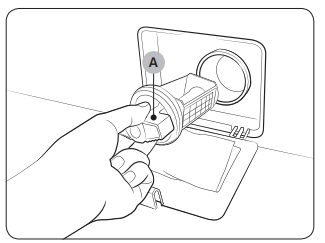
5. Clean the pump filter using a soft brush. Make sure the drain pump propeller inside the filter is not clogged.
6. Reinsert the pump filter, and then turn the filter knob to the right.
7. Close the filter cover.
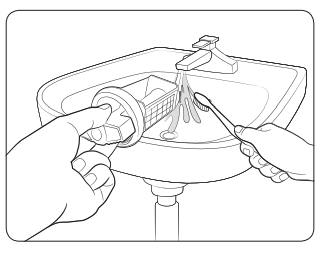
NOTE
- Some pump filters feature a safety knob that is designed to prevent children from accidently opening the filter compartment. To open the safety knob of the pump filter, push in and turn it counterclockwise. The spring mechanism of the safety knob helps open the filter.
- To close the safety knob of the pump filter, turn it clockwise. The spring makes a rattling sound, which is normal.
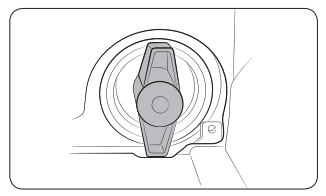
CAUTION
- Make sure the filter knob is closed properly after cleaning the filter. Otherwise, this may cause a leak.
- Make sure the filter is inserted properly after cleaning it. Otherwise, this may cause an operational failure or a leak.
Troubleshooting
Checkpoints
If you encounter an issue to check with the washer, first check the table below and try the suggestions
| Problem | Action |
| Does not turn on |
|
| Does not start |
|
| Water supply is insufficient or no water is supplied.. |
|
| After a cycle, detergent remains in the detergent drawer |
|
| Excessive vibrations or makes noise. |
|
| Does not drain and/or spin. |
|
| Drains with noise. |
|
| The door does not open. |
|
| Excessive suds. |
|
| Cannot add additional detergent. |
|
| The washer stops. |
|
| The washer fills with the wrong temperature water |
|
| The load is wet at the end of a cycle. |
|
| Leaks water. |
|
| Has odors. |
|
| The tub or the water/ drain hose is frozen. |
|
| Water drains out immediately. |
|
If an issue continues to occur, contact a local Samsung service center.
Information codes
If the washer fails to operate, you may see an information code on the screen. Check the table below and try the suggestions.
| Code | Action | |
| Upper washer | Lower washer | |
| 1 1C | 1C |
Check the water level sensor.
|
| dC |
The door is open.
|
|
| 1 dC |
The top door is open.
|
|
| 1 dC4 |
The protective cover is open.
|
|
| 1 dC1 | dC1 |
Check the door switch.
|
| 1 LC | LC |
Check for water leaks.
|
| 1 LC1 | LC1 |
Check the drain hose.
Others
|
| 1 4C | 4C |
Check the water supply line.
|
| 1 4C2 | 4C2 |
The water being supplied is too hot.
|
| 1 5C | 5C |
Check the drain system.
|
| 1 HC | HC |
Check the washing heater.
|
| 1 UB | UB |
Check the spinning process.
|
|
1 8C 1 8C1 1 8C2 |
8C 8C1 8C2 |
Check the MEMS sensor.
|
| 1 OC | OC |
Water may overflow.
|
| 1 3C | 3C |
Check the motor.
|
| 1 AC6 | AC6 |
Check the PBA communication status.
|
|
1 9C1 1 9C2 |
9C1 9C2 |
The electronic control needs to be checked.
|
| 1 SF | SF |
System failed.
|
| 1 AC | AC |
Check communications between main and sub PBAs.
|
| AC7 |
Check communications between the lower main PBA and the upper main PBA
|
|
If any information code keeps appearing on the screen, contact a local Samsung service center
Specifications
Fabric care chart
The following symbols provide garment care direction. The clothing care labels include symbols for drying, bleaching, drying and ironing, or dry cleaning when necessary. The use of symbols ensures consistency among garment manufacturers of domestic and imported items. Follow care label directions to optimize garment life and reduce laundering problems
Wash cycle
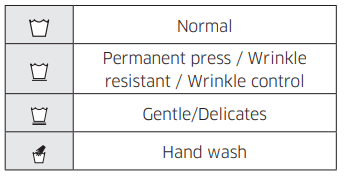
Water temperature

NOTE This represents appropriate wash water temperatures for various items. The temperature range for Hot is 105° - 125 °F / 41° - 52 °C, for Warm 85° - 105 °F / 29° - 41 °C, and for Cold 60° - 85 °F / 16° - 29 °C. (Wash water temperature must be a minimum of 60 °F / 16 °C for detergent activation and effective cleaning.)
Bleach
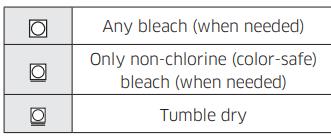
Normal

Special instructions
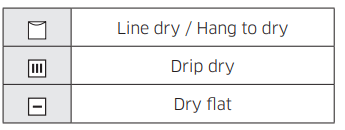
Heat setting
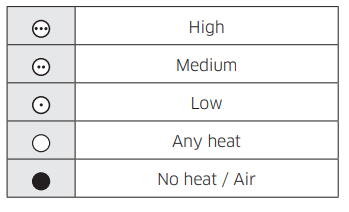
Iron dry or steam temperatures
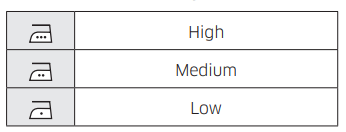
Warning symbols for laundering
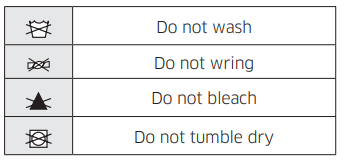

Dry-clean
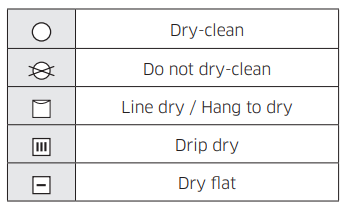
Protecting the environment
- This appliance is manufactured from recyclable materials. If you decide to dispose of it, please observe local waste disposal regulations. Cut off the power cord so that the appliance cannot be connected to a power source. Remove the lid so that animals and small children cannot get trapped inside the appliance
- Do not exceed the detergent quantities recommended in the detergent manufacturers’ instructions.
- Use stain removal products and bleaches before the wash cycle only when necessary.
- Save water and electricity by only washing full loads (the exact amount depends upon the program used).
Declaration of conformity
This appliance complies with UL2157.
Specification sheet
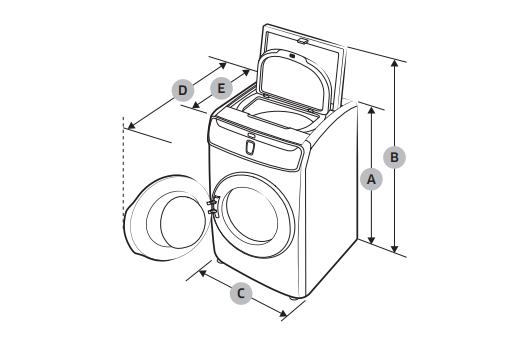
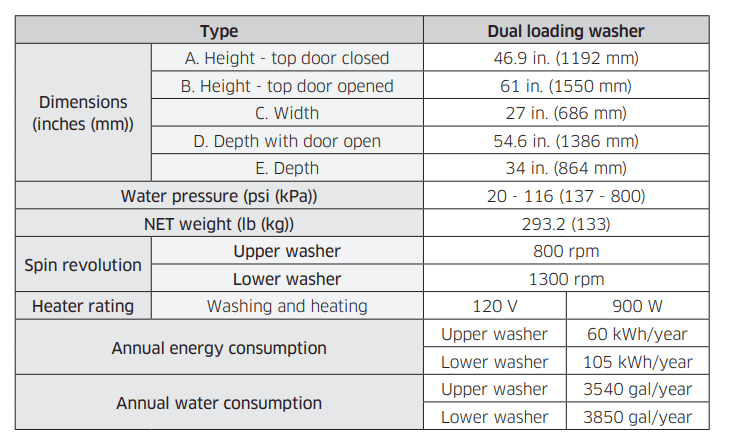
See other models: WV60M9900AV/A5 WA52M7750AV/A4 WF45K6500AV/A2 WF50K7500AV/A2 WF42H5000AW/A2

